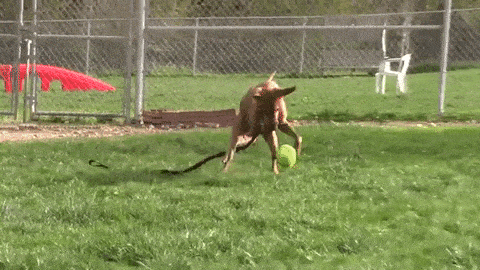It’s also hard to know when to go to the vet if your dog starts limping.
Do you need to pick up and go right away, or can you wait for a couple of days to see if everything settles down? What if your dog is limping but doesn’t seem to be in pain? What is your veterinarian going to do for your limping dog anyway? Is it a broken bone or just a pulled muscle?
If you have dogs for long enough, you’re bound to have one of them start limping from one thing or another. When your dog is limping it can be scary because they can’t tell us what is wrong, leaving us to figure out for ourselves what might have happened. In this article, we’ll go over some of the major causes of limping and then discuss when you do need to take your dog to the vet!
What are the causes of limping in dogs
One of the most important things in differentiating potential causes of lameness is whether the limping has had a gradual onset or occurred suddenly.
Gradual Onset Lameness Issues
Gradual onset injuries can usually wait a little while before you take your dog to the veterinarian, so you don’t need to rush right out to the emergency vet. These types of problems are usually degenerative and include health issues such as arthritis or dysplasia.
In many cases with an older dog and a slow progression of onset, you’re dealing with a case of arthritis. Arthritis is one of the most common health issues affecting dogs as they age, and there are a variety of treatment options, such as anti-inflammatory pain medications and treatment with supplements containing glucosamine and chondroitin. Dysplasia usually occurs within the hips or the elbows and may require surgery to fix.
Sudden Onset Lameness Issues
Sudden or acute onset injuries tend to occur when a pet has been running or jumping, but they can also occur when something happens, such as you tripping over your puppy. These types of injuries tend to be the most problematic because your veterinarian needs to determine if it’s a soft tissue injury or a bone injury.

Examples of acute injuries include broken bones, such as your dog breaking a bone in their paw like a metatarsal. Athletic dogs who do a lot of running and jumping, as well as overweight dogs and certain breeds, are at a high risk for cranial cruciate ligament ruptures. With this health condition, a ligament within the knee tears partially or completely, causing acute lameness, similar to an ACL injury in humans. While some dogs do well with rest, others need surgery to correct the injury.
When should I take my dog to the vet for limping?
If your dog is limping for any reason, it’s important to get them in to see your veterinarian. Even if they don’t seem to be in pain, they most likely are and it is important to resolve it. Wait a few minutes after you notice the limping to see if it will resolve on its own first, such as if your dog stepped on a rock that hurt his paw. With an acute injury, it’s generally important to get to the veterinarian sooner than with a gradual onset of limping.
Red flags that indicate your dog needs to go to the veterinarian relatively immediately include:
- If they have heat or swelling around any of their limbs. This can indicate a severe injury such as a broken bone.
- If your dog is holding their limb at an unnatural angle, it’s also important to get them seen sooner rather than later.
- If the limb is dangling, which can indicate an issue such as a neurologic problem or a dislocation.

What to do when your dog is limping
The first thing you should do when you notice your dog limping is to take a deep breath. Panicking will not help you or them. In some cases your dog’s limping may resolve itself in a few minutes, if not it is best to get them booked in for a same-day appointment with your vet.
Watch and wait for a few minutes
Carefully watch your dog or puppy walk: are they using all four of their legs? Which leg are they favoring? Contain them as much as possible and give them a few minutes to rest. Some injuries will resolve themselves quickly, especially with clumsy puppies who run around and crash into things.
Take a careful look at your dog
If the limping hasn’t gone away after a few minutes, take a careful look at your dog. You’ll want to be cautious as a dog in pain can bite, even the people that he loves the most. If your dog is in too much pain, transport him immediately to the emergency veterinarian. Otherwise, look for a painful area or swollen area that could indicate a problem. If your dog lets you, make sure to check his paws, especially around his toes and nails, where he could’ve stepped on something sharp.
Take your dog to the vet for further examination and treatment
It’s time to make that appointment with your veterinarian, who will go through your dog’s physical exam to help isolate a potential cause of the limping and make treatment recommendations.
Treatment options from your veterinarian
When your veterinarian sees your dog, they’ll start by taking a history, getting relevant information about what was happening when your dog started limping, such as playing in the backyard.
A physical exam to isolate the problem
Your vet will then perform a careful physical exam. Note that your dog might be in so much pain that your veterinarian needs to give pain medication or a sedative in order to fully examine your dog. It’s for their safety and comfort.
Additional tests
Once your veterinarian has isolated the problem, they may need to perform additional tests. Radiographs, which are commonly referred to as X-rays, may be needed to rule out a broken bone or cruciate injury. If your vet is worried about a metabolic cause of lameness, such as Lyme disease, they may perform certain blood tests.
Broken bones will need to be splinted or casted
If your dog has a broken bone, it will need to be splinted or casted. In some circumstances, your veterinarian may recommend surgery or a surgical referral to heal your dog, as in the case of many cruciate ligament injuries.

Pain medications
A mainstay of treating lameness issues is using pain medications. There are several classes of medications that may be used, and the most common is a non-steroidal anti-inflammatory, such as carprofen or Galliprant (grapiprant). Your veterinarian may need to add in additional pain medications, such as gabapentin, or use a muscle relaxer for your dog, which could include methocarbamol.
Exercise restrictions
Your dog will also generally be placed on exercise restriction. This term means that they will likely need to be kept in a crate or a room so that their activity level is contained. You’ll need to take them on short leash walks to go to the bathroom and not let them jump up and down. Your veterinarian will give you a suggested length on how long your dog should have exercise restriction, which may last anywhere from a few days to a few weeks, especially if surgery is needed.
Don’t panic and get your dog to the vet!
There are many different reasons why your dog might start limping, and you’ll generally need to take them to the veterinarian to be diagnosed and get treatment. Even if it is a simple sprain that will take a few days to heal, this will need to be diagnosed by a professional.
It’s important to note that you shouldn’t use any human pain medications for your dog, as some of these medications can be very toxic to dogs and also limit what your veterinarian can prescribe for them. Before taking your dog to the vet, try resting them to see if they recover quickly and contact your veterinarian’s office if you have any questions.










